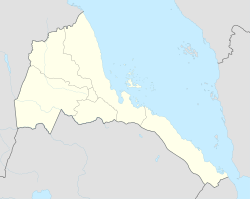Assab
| Assab | ||
|---|---|---|
|
|
||
| Coordinates | 13 ° 0 ′ N , 42 ° 45 ′ E | |
| Basic data | ||
| Country | Eritrea | |
| Debubawi Kayih Bahri | ||
| ISO 3166-2 | ER-DK | |
| height | 12 m | |
| Residents | 21,300 | |
|
Orthodox Church in Assab
|
||
Assab (Ge'ez ዓሰብ ʿAsäb , Arabic عصب), more rarely also Aseb , is a small port town with around 21,300 inhabitants in southeast Eritrea and the capital of the administrative region Debubawi Kayih Bahri . The city is about 480 kilometers as the crow flies from the capital Asmara on the Red Sea .
The sea port of Assab was a strategically important point for trade with Ethiopia and one of the reasons for the Eritrea-Ethiopia war . There are 30 islands in the Bay of Assab. In the vicinity there is a large salt flat and the Assab volcanic field . There is also an important oil refinery and an international airport. The city consists of the parts Assab Seghir on the coast, Assab Kebir in the city center (including the port district) and Campo Sudan .
history
Colonialism in the 19th Century
The Bay of Assab was the first Italian colonial area in East Africa .
The shipowner Raffaele Rubattino from Genoa , in agreement with the Italian government, decided to build a dock with a warehouse for coal on the Red Sea for the benefit of his ships that sailed in the Indian Ocean . In order not to attract the attention of the European public, a local specialist was commissioned to acquire the Bay of Assab on behalf of the Rubattino company.
On November 5, 1869, a triangular piece of land was acquired by two local leaders, Ibrahim and Hasan, 6 km in base length and 6 km in length perpendicular to the base. The contract signed on March 11, 1870 was celebrated on board the steamer Africa by the Rubattino Society. Signs were smashed along the boundaries of the land acquired, stating Property of Rubattino: Acquired on March 11, 1870 . But before the end of the month, Egyptian soldiers took possession of the bay again and cleared away stakes and signs.
In March 1880 Giuseppe Sapeto acquired the bay again through another contract, as well as other pieces of land and islands in the vicinity.
On March 10, 1882, the Italian government took over the Assab area from the shipping company. In 1880 a civil district was established under the supervision of the Italian Ministry of Foreign Affairs. In 1883, a small association of four Carabinieri set up a supervisory post for commercial traffic on the orders of Marshal Enrico Cavedani . The sergeant later also hired locals, who later became the gendarmerie units (Zaptié) of the colony of Eritrea .
Assab post office
When Rubattino & Co. took ownership of Assab, there was a post office there under the supervision of an accountant for the company. When the colony of Eritrea was established on January 1, 1890, Assab became the colony's main post office district and used the postage stamps issued for the colony itself.
British control
In June 1941 the British captured Assab, the last Italian port in the Red Sea. In 1952, control of all of Eritrea was transferred to the United Nations .
The port and refinery of Assab in the 1990s
For the relationship with Ethiopia, the port and the refinery are particularly important. After Eritrea's independence in 1993, Ethiopia was given the right to import its goods duty-free via the Eritrean city of Assab to compensate for the loss of its access to the sea. The port there was declared a free port and Ethiopia received the right to use the refinery in exchange for 30% of the Ethiopian oil. At the end of 1996 Eritrea increased the user fees for the refinery in Assab by 10%, whereupon Ethiopia stopped mining its own oil and instead purchased finished petrochemical products from the world market. As a result, Eritrea had to buy its petrochemical products on the open market and shut down its unprofitable refinery. After Eritrean units occupied the Yirga triangle in the border area on May 12, 1998, Ethiopia imposed a total economic boycott on Eritrea, whereupon Eritrea closed not only the port of Massawa but also the port in Assab to Ethiopia, through which Ethiopia conducted two thirds of its foreign trade.
Climate table
| Assab | ||||||||||||||||||||||||||||||||||||||||||||||||
|---|---|---|---|---|---|---|---|---|---|---|---|---|---|---|---|---|---|---|---|---|---|---|---|---|---|---|---|---|---|---|---|---|---|---|---|---|---|---|---|---|---|---|---|---|---|---|---|---|
| Climate diagram | ||||||||||||||||||||||||||||||||||||||||||||||||
| ||||||||||||||||||||||||||||||||||||||||||||||||
|
Average monthly temperatures and rainfall for Assab
Source: wetterkontor.de
|
|||||||||||||||||||||||||||||||||||||||||||||||||||||||||||||||||||||||||||||||||||||||||||||||||||||||||||||||||||||||||||||||||||||||
literature
- Edward Ullendorff: The Ethiopians: An Introduction to Country and People . 2nd Edition. Oxford University Press, London 1965, ISBN 0-19-285061-X , pp. 90 .

